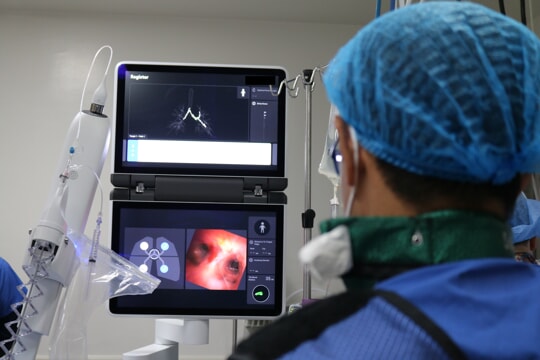
Advancing Lung Cancer Detection with Robotic Bronchoscopy
As part of our commitment to providing life-enhancing health care through the use of advanced technologies, Pomona Valley Hospital Medical Center now offers a minimally invasive robotic-assisted bronchoscopy procedure with Ion.
Ion uses an ultra-thin, highly maneuverable robotic catheter to reach parts of the lung not possible through a standard biopsy. The Ion offers enhanced precision and is able to reach more tissue to better detect lung cancer.
“The ION technology greatly increases the amount of specimen we can collect and analyze, especially from peripheral lung lesions, where limited tissue is able to be sampled,” says Catherine Suen, DO, Pathologist at the PVHMC Laboratory. “ION’s ability to take precise samples of this lesion tissue allows our team to rapidly analyze the lesion and verify if it is benign, malignant or infectious. Then we can determine if additional testing needs to be conducted on the lesion. This technology is crucial in the accurate diagnosis of lung lesions.”
What is Ion Robotic Bronchoscopy?
The Ion, a robotic-assisted surgical system, uses an ultra-thin maneuverable catheter that can navigate deeper into lung tissue than traditional lung biopsy methods. The technology allows access to all lung nodules for more precise biopsies, and jump-starts diagnoses and treatments. CT scan data is used to generate a 3D image of the patient’s lungs down to the branches and nodules.
Ion made by Intuitive, maker of the da Vinci surgical system, is built on more than two decades of leadership in robotic-assisted technology.

Learn more about the robotic bronchoscopy process here.
How does robotic bronchoscopy work?
To perform a bronchoscopy, the pulmonologist uses the Ion controller to the ultrathin catheter along a preplanned route to a nodule. The catheter has a 180-degree articulation and is flexible, allowing tight turns in the branches of the lung to easily access nodules. The catheter locks onto the nodule, and a system needle obtains the tissue sample.
After the biopsy, the tissue sample is sent to a pathologist to assess for cancer cells and results are provided to the surgical team within minutes.
This allows the pulmonologist to rapidly diagnose the patient during the procedure. If lung cancer is indicated, the pulmonologist will evaluate the stage of cancer and work with the patient’s health care team to establish a treatment plan.
“The Ion allows us to perform biopsies with higher precision and detect abnormalities in the lungs, such as cancer, earlier than we previously could,” says Anthony Gan, DO, pulmonologist and critical care physician at PVHMC. “Early detection can lead to more treatment options and successful outcomes for our patients.”
Learn more about the lung cancer program here.
Who should have a Robotic Bronchoscopy?
If you recently learned you have a suspicious mass or nodule on your lung, you may find yourself struggling to cope with the uncertainty of whether the nodule is benign or cancerous.
While most nodules may be benign, your doctor may recommend additional procedures, such as a biopsy, to determine a diagnosis. A biopsy involves obtaining a tissue sample from the suspicious area and examining the cells under a microscope to determine if cancer or another disease is present. The type of biopsy procedure your doctor will recommend depends on the size of the nodule, its location within the lung and your overall health.
If your doctor suggests robotic-assisted bronchoscopy with Ion, you will be scheduled for a procedure through our Pre-Admit Services Department.
If you are concerned about your risk of lung cancer, talk to your doctor today. Based on your risk factors and smoking history, you may be eligible for a lung CT screening for lung cancer. Visit www.mypvhc.com to find a primary care physician in your neighborhood.
.png)